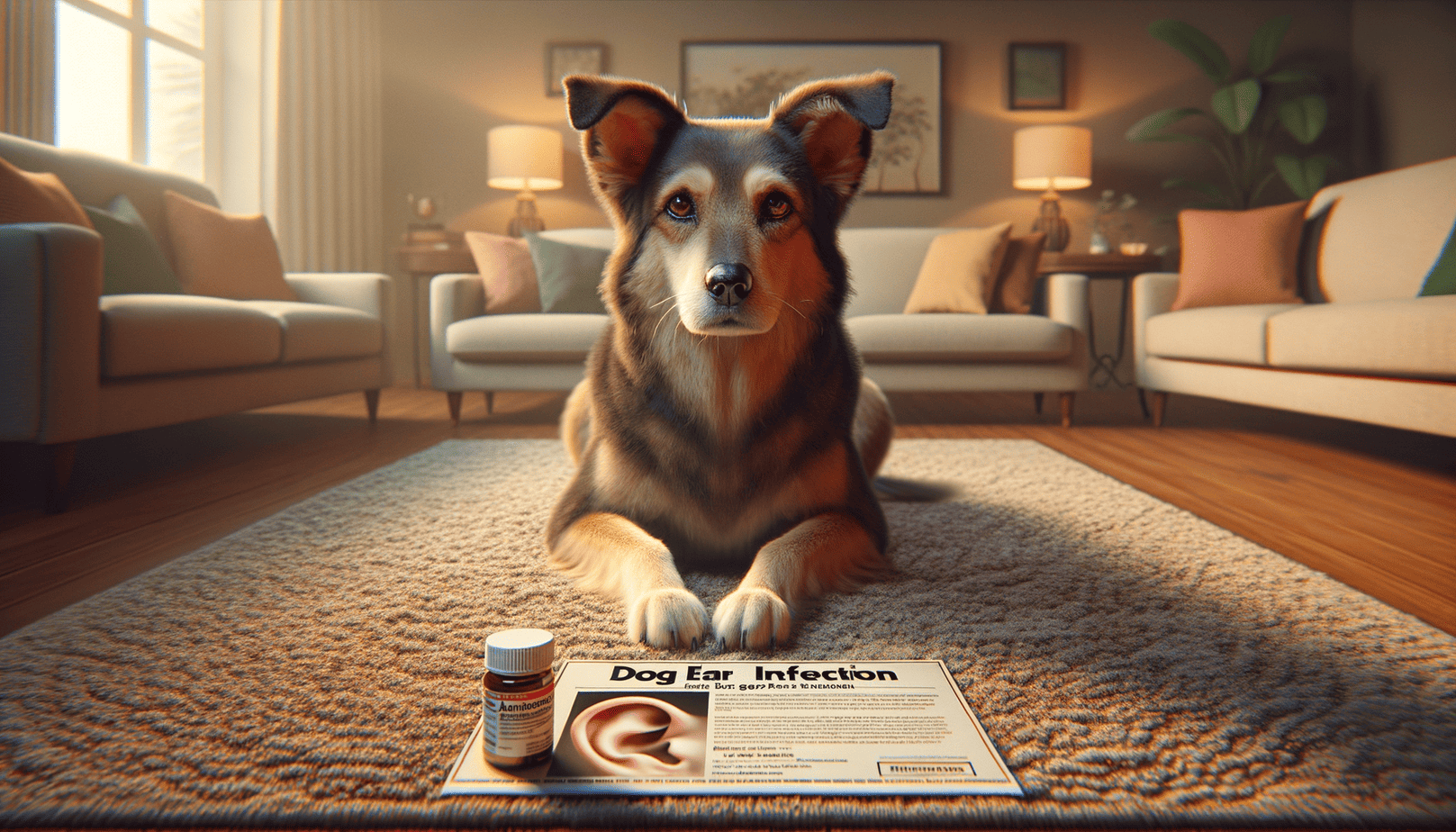As a devoted dog parent, it’s heart-wrenching to see your furry friend in distress due to an ear infection. You’re probably wondering if antibiotics are the best route to take. In this article, titled “Antibiotics for Dog Ear Infections: Pros & Cons”, we’ll explore the good and bad of using antibiotics for treating your dog’s ear infection. We’ll also discuss alternatives and preventive measures to help your pooch stay healthy. So, let’s dive in and equip ourselves with the knowledge to make the best decisions for our four-legged family members.

Understanding Dog Ear Infections
If you’ve ever seen your four-legged friend scratching their ears relentlessly or shaking their head more than usual, it’s possible they might be suffering from an ear infection. Ear infections in dogs are quite common and can be caused by various factors. Having a comprehensive understanding of these infections is key to ensuring your pet’s well-being, and knowing when it might be time to consider antibiotics.
Causes of Dog Ear Infections
Ear infections in dogs are often caused by bacteria or yeast. However, other factors such as allergies, ear mites, foreign bodies lodged in the ear, or excessive moisture can also lead to these infections. Certain breeds with floppy ears, like Basset Hounds and Cocker Spaniels, are more prone to ear infections due to their ear structure which can trap moisture and debris.
Environmental factors like humidity and swimming can also contribute to an increased risk of ear infections. Additionally, dogs with underlying health issues such as hormonal imbalances or immune disorders are more susceptible to developing infections.
Symptoms of Dog Ear Infections
Recognizing the symptoms of an ear infection is crucial in seeking timely treatment for your pet. Some common symptoms include:
- Scratching or rubbing of the ears and head
- Odor or discharge from the ears
- Redness or swelling in the ear canal
- Pain or discomfort when the ears are touched
- Loss of balance or coordination, in severe cases
It’s important to remember that symptoms can vary depending on the severity of the infection and the underlying cause. If you notice any of these signs, it’s best to consult with your veterinarian promptly. They can diagnose the condition accurately and advise on the most effective treatment strategy, which may include the use of antibiotics.
Knowing the causes and symptoms of dog ear infections is the first step in protecting your pet’s health. In the following sections, we will explore the role of antibiotics in treating these infections, their pros and cons, alternatives, and more. Stay tuned to learn all about dog ear infection antibiotics: the good and the bad.
Role of Antibiotics in Treating Dog Ear Infections
As a veterinarian, I often encounter worried pet parents inquiring about the best treatment for their dog’s ear infection. The key, my dear friend, is to understand the role of antibiotics in these situations. They can be a powerful tool in combating these infections, but as with any medication, there are both good and bad aspects to consider.
How Antibiotics Work Against Ear Infections:
Antibiotics are specifically designed to fight bacterial infections. When your dog has an ear infection, the bacteria causing the infection are multiplying rapidly. Antibiotics work by inhibiting the bacteria’s ability to reproduce, thus controlling the infection. Some antibiotics also kill the bacteria directly. The relief for your furry friend can be quite rapid with the right antibiotic.
Types of Antibiotics Used for Dog Ear Infections:
- Cephalexin: This is a common antibiotic used to treat a variety of bacterial infections in dogs, including ear infections.
- Amoxicillin: Another popular choice, Amoxicillin is used to combat various types of infections in dogs. It is often used when the infection is mild to moderate.
- Enrofloxacin: This antibiotic is often used when other antibiotics have proven ineffective. It’s powerful and can tackle severe infections.
Now, when we talk about dog ear infection antibiotics the good and bad, it’s important to remember that each dog is unique. What works for one might not work for another. So, it’s crucial to consult with a veterinarian who can examine your dog and prescribe the best antibiotic for their specific situation.
In the next section, we will delve deeper into the pros and cons of using antibiotics for dog ear infections. This will help you make an informed decision about your dog’s health and well-being.
Antibiotics for Dog Ear Infections: Pros & Cons
Effectiveness in Treating Bacterial Infections
One of the primary advantages of using antibiotics for dog ear infections is their proven effectiveness in treating bacterial infections. Antibiotics are designed to combat bacteria, either by killing them directly or inhibiting their growth, thus giving your dog’s immune system a chance to fight off the infection. When your dog is suffering from a bacterial ear infection, antibiotics can be a real game-changer, alleviating the distressing symptoms and promoting quick recovery.
Speed of Relief Provided by Antibiotics
Another significant benefit of antibiotics is the speed of relief they provide. Once the right antibiotic is administered, it quickly gets to work, reducing inflammation and pain. In many cases, you may notice an improvement in your dog’s condition within just a few days of starting the antibiotic treatment, which is a great relief for both you and your furry friend.
However, it’s important to remember that antibiotics should be used responsibly. Even if your dog seems to be feeling better, it’s crucial to complete the full course of antibiotics prescribed by your vet. This helps to ensure that all the bacteria causing the infection are eliminated, preventing a potential relapse.
Antibiotics: A Powerful Ally
In conclusion, antibiotics for dog ear infections can be incredibly beneficial. They offer a powerful solution to bacterial infections, providing quick relief and promoting full recovery. However, like all medications, they should be used responsibly under the guidance of a vet. Remember, the aim is not just to treat the current infection but also to prevent future ones. By using antibiotics correctly, you can help ensure your dog’s ears stay healthy and infection-free.
As a dog parent, it’s essential to weigh the good and the bad when it comes to using antibiotics for your dog’s ear infection. While they offer quick and effective relief, it’s important to be aware of potential side effects and the risk of antibiotic resistance. Always consult with your vet before starting any new medication for your dog.

Cons of Using Antibiotics for Dog Ear Infections
While antibiotics can play a crucial role in treating dog ear infections, it’s important to understand they also come with potential drawbacks. As a responsible pet parent, it’s crucial to know both the good and the bad when it comes to dog ear infection antibiotics.
Possible Side Effects of Antibiotics in Dogs
Like any medication, antibiotics can cause side effects. While these vary depending on the specific drug and the dog’s overall health, some common side effects include:
- Upset stomach: Dogs may experience vomiting, diarrhea, or loss of appetite.
- Allergic reactions: Hives, difficulty breathing, or sudden behavioral changes could indicate an allergic reaction.
- Yeast overgrowth: Antibiotics can disrupt the natural balance of bacteria in your dog’s body, leading to yeast overgrowth, especially in the ears and skin.
It’s crucial to monitor your dog closely while they’re on antibiotics and to contact your vet immediately if you notice any adverse reactions.
Risk of Antibiotic Resistance
Another significant concern with the use of antibiotics is the risk of antibiotic resistance. This happens when bacteria evolve to resist the effects of an antibiotic. Overuse or improper use of antibiotics can accelerate this process.
For example, if a dog doesn’t complete the full course of antibiotics, some bacteria may survive and develop resistance to the drug. The next time that dog gets an ear infection, the same antibiotic may not work as effectively.
Disruption of Gut Flora
Antibiotics don’t just kill off the harmful bacteria causing the ear infection; they can also affect the beneficial bacteria in your dog’s gut. This disruption can lead to digestive issues and potentially impact your dog’s overall health and immune system.
In conclusion, while antibiotics can be highly effective in treating dog ear infections, their use should be carefully considered and monitored. Always consult with your vet to ensure you’re making the best decision for your furry friend’s health.
Alternatives to Antibiotics for Dog Ear Infections
While antibiotics are often a go-to treatment for dog ear infections, it’s important to explore other options, especially if your furry friend is prone to side effects or has developed antibiotic resistance. Let’s take a look at some natural remedies and preventive measures that can help keep your dog’s ears healthy.
Natural Remedies for Dog Ear Infections
There are several natural treatments that can provide relief for your dog’s ear infection. However, it’s crucial to consult with your vet before starting any new treatment. Here are a few options:
- Apple Cider Vinegar: Known for its antifungal and antibacterial properties, apple cider vinegar can help to fight off infections. Dilute it with equal parts water and apply it to the infected area.
- Mullein and Garlic Oil: Both mullein and garlic have antibacterial properties and can be used to treat ear infections. You can find pre-made oils at holistic pet stores or make your own at home.
- Probiotics: Probiotics not only improve gut health but can also boost your dog’s immune system, helping to prevent ear infections.
Preventive Measures Against Ear Infections
Prevention is always better than cure. Here are some preventive measures you can take to prevent ear infections in your dog:
- Regular Cleaning: Regularly cleaning your dog’s ears can help prevent the buildup of bacteria and yeast that cause infections. Use a vet-approved cleaner and gently clean the ears without digging too deep.
- Diet: A healthy diet is crucial for a healthy immune system. Ensure your dog’s diet is balanced and includes all the necessary nutrients. Some dogs may benefit from a diet low in allergens, as allergies can contribute to ear infections.
- Avoid Moisture: Moisture in the ears can create an ideal environment for bacteria and yeast to grow. Try to keep your dog’s ears dry, especially after baths or swimming.
Remember, every dog is unique and what works for one may not work for another. Always consult with your vet before starting any new treatment or preventive measure. Your vet can provide personalized advice based on your dog’s breed, age, and overall health.

List of Breeds Prone to Ear Infections
Some dog breeds are more prone to ear infections than others. This is often due to the shape and size of their ears, their grooming needs, or their genetic predispositions. Let’s take a closer look at a few of these susceptible breeds and why they’re more likely to develop ear infections:
Cocker Spaniels
Cocker Spaniels are known for their beautiful, long, floppy ears. However, these ears can trap moisture and prevent adequate airflow, creating a perfect environment for bacteria and yeast to thrive. Regular ear cleaning is essential for this breed.
Basset Hounds
Basset Hounds are another breed with long, droopy ears. Their ears can easily drag on the ground and pick up dirt and debris, increasing the risk of infection. Their ear canals are also more horizontal than those of other breeds, which can lead to fluid build-up.
Labrador Retrievers
Labrador Retrievers love water, but their fondness for swimming can put them at risk for ear infections. Water can get trapped in their ears, promoting bacterial growth. If you have a Lab who loves to swim, consider regular ear checks and drying their ears thoroughly after each swim.
Poodles and Poodle Mixes
Poodles and Poodle mixes have hair that grows inside their ear canals, which can trap debris and moisture. Regular grooming and ear checks are vital for these breeds to prevent ear infections.
Shar Peis
Shar Peis have narrow, tightly curled ear canals, making it difficult for air to circulate. This can lead to a moist environment where bacteria and yeast can flourish. Regular ear cleaning and checks are important for this breed.
Understanding your dog’s breed and its predisposition to ear infections can help you take preventive measures. This could include regular ear checks, cleaning, and grooming, as well as being aware of the symptoms of ear infections. Remember, early detection and treatment can help prevent complications and keep your furry friend comfortable and happy.
Antibiotics for Dog Ear Infections: Pros & Cons
We’ve taken a comprehensive look at the causes, symptoms, and treatment options for dog ear infections, with a particular focus on antibiotics. Understanding the pros and cons of using antibiotics for dog ear infections is crucial in making informed decisions about your pet’s health.
Antibiotics can be highly effective in treating bacterial infections, often providing quick relief. However, they are not without potential drawbacks. Side effects can occur, and the risk of antibiotic resistance is a growing concern.
It’s essential to also consider alternatives to antibiotics for treating dog ear infections. Natural remedies and preventive measures can play a significant role in your pet’s health, potentially helping to avoid the need for antibiotics altogether.
Knowing that certain breeds are more susceptible to ear infections can further guide your decisions about treatment and prevention. Armed with this knowledge, you can take proactive steps to protect your pet’s health.
In the end, the most important thing is to ensure that your furry friend receives the appropriate treatment for their ear infections. Always consult with your vet to determine the best course of action. As pet parents, we all want our dogs to lead happy, healthy lives. Adequate treatment and prevention of ear infections are important parts of that goal.
Remember, when it comes to dog ear infection antibiotics the good and bad, it’s all about balance. Use them when necessary, but also explore other options that might be better suited to your pet’s specific needs. The health and happiness of your four-legged family member are well worth the effort.
Frequently Asked Questions
Q1: What are the pros of using antibiotics for dog ear infections?
Antibiotics are often effective in treating bacterial infections, including those in a dog’s ear. They can help to quickly reduce symptoms and prevent the infection from spreading.
Q2: What are the cons of using antibiotics for dog ear infections?
While antibiotics can be effective, they also have potential downsides. Overuse can lead to antibiotic resistance, making future infections harder to treat. Some dogs may also experience side effects such as nausea, vomiting, or diarrhea.
Q3: Are there alternatives to antibiotics for treating dog ear infections?
Yes, depending on the cause of the infection, there may be alternatives to antibiotics. For example, antifungal medications can be used for fungal infections, and certain types of ear drops can help with inflammation and pain.
Q4: How can I prevent my dog from getting ear infections?
Regular ear cleaning can help prevent infections. It’s also important to keep your dog’s ears dry, as moisture can create an environment where bacteria and yeast can grow. If your dog has allergies, managing those can also help prevent ear infections.
Q5: Should I consult with a vet before giving my dog antibiotics?
Yes, always consult with a vet before giving your dog any new medication, including antibiotics. They can provide guidance on the best treatment options based on your dog’s specific needs and health history.
